Decision Making Skills Quiz - Psychology Assignment Solution
VerifiedAdded on 2023/02/01
|6
|1432
|22
Homework Assignment
AI Summary
This assignment explores various aspects of decision-making skills through a quiz format. The first section examines the impact of stress on group decision-making, including its effects on quick decisions, the reflection effect, and decision fatigue, with a personal reflection on overcoming stress in a group project. The second section delves into the concept of non-decision decisions, differentiating between active and passive approaches, and providing examples. It also explores reasons for passive approaches and ways to avoid them. The third section focuses on intuition and systematic approaches, defining intuition, providing a personal example of moral intuition, and contrasting it with the systematic approach to problem-solving. It also includes an example of using a systematic approach in a classroom setting, referencing relevant academic literature.
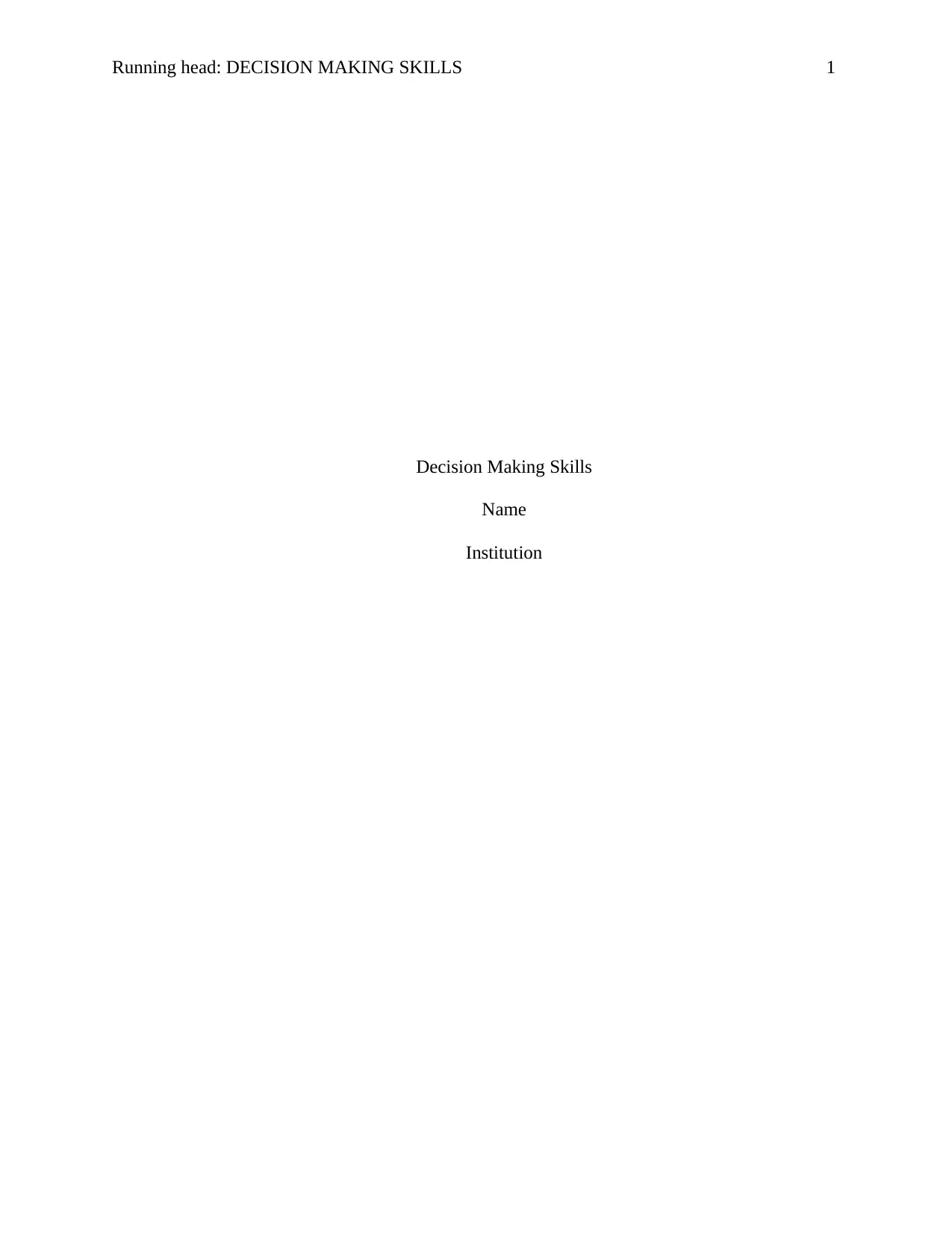
Running head: DECISION MAKING SKILLS 1
Decision Making Skills
Name
Institution
Decision Making Skills
Name
Institution
Paraphrase This Document
Need a fresh take? Get an instant paraphrase of this document with our AI Paraphraser
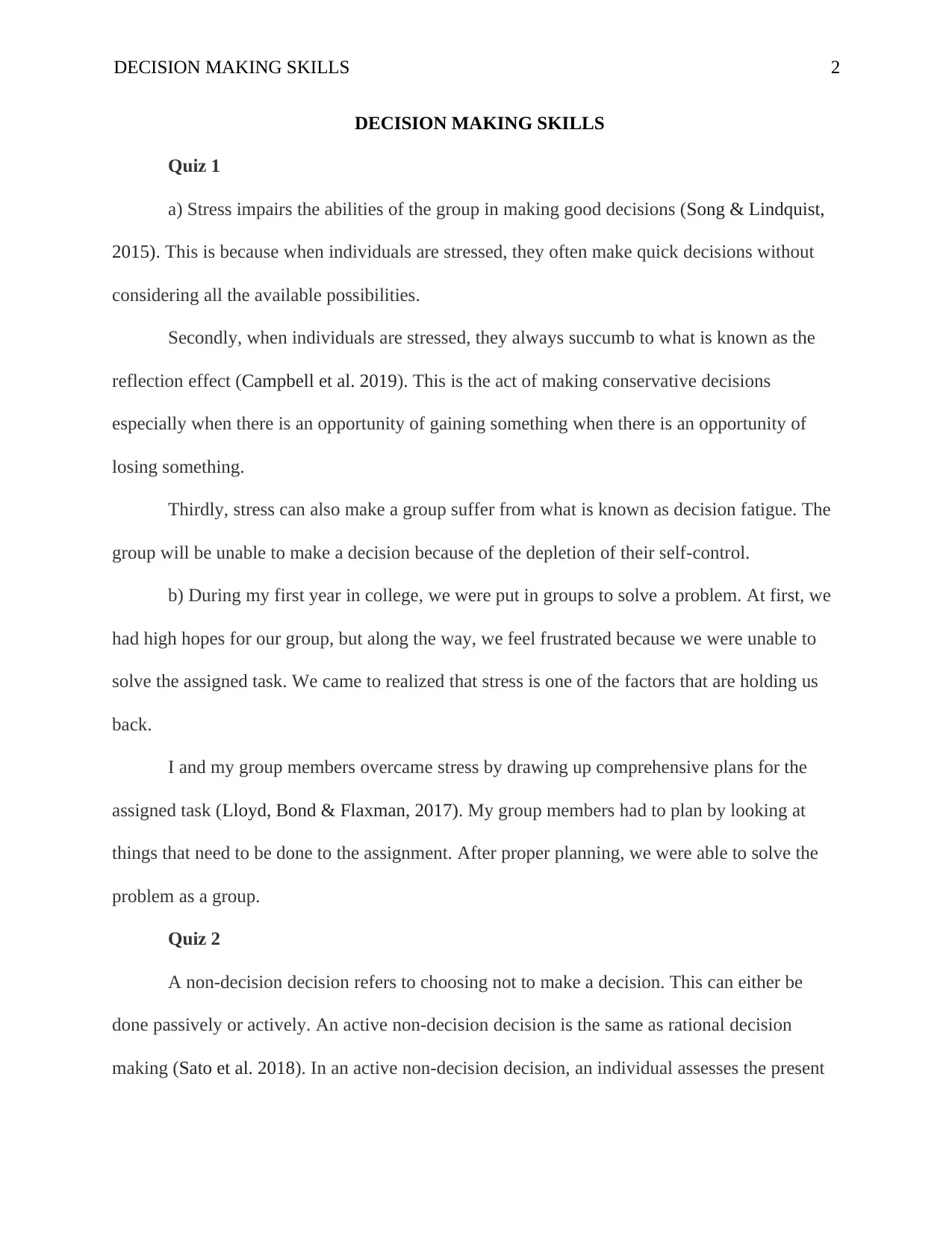
DECISION MAKING SKILLS 2
DECISION MAKING SKILLS
Quiz 1
a) Stress impairs the abilities of the group in making good decisions (Song & Lindquist,
2015). This is because when individuals are stressed, they often make quick decisions without
considering all the available possibilities.
Secondly, when individuals are stressed, they always succumb to what is known as the
reflection effect (Campbell et al. 2019). This is the act of making conservative decisions
especially when there is an opportunity of gaining something when there is an opportunity of
losing something.
Thirdly, stress can also make a group suffer from what is known as decision fatigue. The
group will be unable to make a decision because of the depletion of their self-control.
b) During my first year in college, we were put in groups to solve a problem. At first, we
had high hopes for our group, but along the way, we feel frustrated because we were unable to
solve the assigned task. We came to realized that stress is one of the factors that are holding us
back.
I and my group members overcame stress by drawing up comprehensive plans for the
assigned task (Lloyd, Bond & Flaxman, 2017). My group members had to plan by looking at
things that need to be done to the assignment. After proper planning, we were able to solve the
problem as a group.
Quiz 2
A non-decision decision refers to choosing not to make a decision. This can either be
done passively or actively. An active non-decision decision is the same as rational decision
making (Sato et al. 2018). In an active non-decision decision, an individual assesses the present
DECISION MAKING SKILLS
Quiz 1
a) Stress impairs the abilities of the group in making good decisions (Song & Lindquist,
2015). This is because when individuals are stressed, they often make quick decisions without
considering all the available possibilities.
Secondly, when individuals are stressed, they always succumb to what is known as the
reflection effect (Campbell et al. 2019). This is the act of making conservative decisions
especially when there is an opportunity of gaining something when there is an opportunity of
losing something.
Thirdly, stress can also make a group suffer from what is known as decision fatigue. The
group will be unable to make a decision because of the depletion of their self-control.
b) During my first year in college, we were put in groups to solve a problem. At first, we
had high hopes for our group, but along the way, we feel frustrated because we were unable to
solve the assigned task. We came to realized that stress is one of the factors that are holding us
back.
I and my group members overcame stress by drawing up comprehensive plans for the
assigned task (Lloyd, Bond & Flaxman, 2017). My group members had to plan by looking at
things that need to be done to the assignment. After proper planning, we were able to solve the
problem as a group.
Quiz 2
A non-decision decision refers to choosing not to make a decision. This can either be
done passively or actively. An active non-decision decision is the same as rational decision
making (Sato et al. 2018). In an active non-decision decision, an individual assesses the present
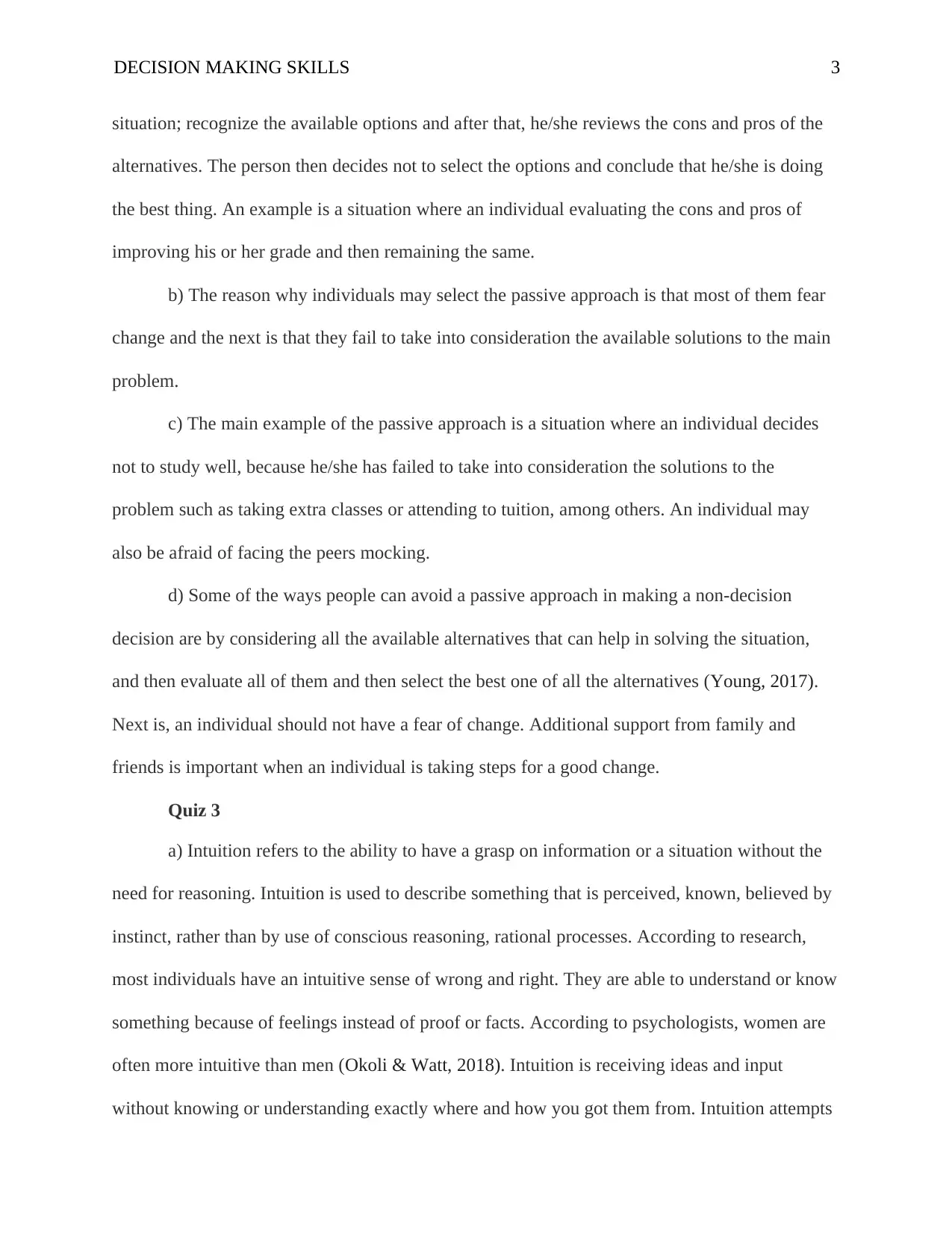
DECISION MAKING SKILLS 3
situation; recognize the available options and after that, he/she reviews the cons and pros of the
alternatives. The person then decides not to select the options and conclude that he/she is doing
the best thing. An example is a situation where an individual evaluating the cons and pros of
improving his or her grade and then remaining the same.
b) The reason why individuals may select the passive approach is that most of them fear
change and the next is that they fail to take into consideration the available solutions to the main
problem.
c) The main example of the passive approach is a situation where an individual decides
not to study well, because he/she has failed to take into consideration the solutions to the
problem such as taking extra classes or attending to tuition, among others. An individual may
also be afraid of facing the peers mocking.
d) Some of the ways people can avoid a passive approach in making a non-decision
decision are by considering all the available alternatives that can help in solving the situation,
and then evaluate all of them and then select the best one of all the alternatives (Young, 2017).
Next is, an individual should not have a fear of change. Additional support from family and
friends is important when an individual is taking steps for a good change.
Quiz 3
a) Intuition refers to the ability to have a grasp on information or a situation without the
need for reasoning. Intuition is used to describe something that is perceived, known, believed by
instinct, rather than by use of conscious reasoning, rational processes. According to research,
most individuals have an intuitive sense of wrong and right. They are able to understand or know
something because of feelings instead of proof or facts. According to psychologists, women are
often more intuitive than men (Okoli & Watt, 2018). Intuition is receiving ideas and input
without knowing or understanding exactly where and how you got them from. Intuition attempts
situation; recognize the available options and after that, he/she reviews the cons and pros of the
alternatives. The person then decides not to select the options and conclude that he/she is doing
the best thing. An example is a situation where an individual evaluating the cons and pros of
improving his or her grade and then remaining the same.
b) The reason why individuals may select the passive approach is that most of them fear
change and the next is that they fail to take into consideration the available solutions to the main
problem.
c) The main example of the passive approach is a situation where an individual decides
not to study well, because he/she has failed to take into consideration the solutions to the
problem such as taking extra classes or attending to tuition, among others. An individual may
also be afraid of facing the peers mocking.
d) Some of the ways people can avoid a passive approach in making a non-decision
decision are by considering all the available alternatives that can help in solving the situation,
and then evaluate all of them and then select the best one of all the alternatives (Young, 2017).
Next is, an individual should not have a fear of change. Additional support from family and
friends is important when an individual is taking steps for a good change.
Quiz 3
a) Intuition refers to the ability to have a grasp on information or a situation without the
need for reasoning. Intuition is used to describe something that is perceived, known, believed by
instinct, rather than by use of conscious reasoning, rational processes. According to research,
most individuals have an intuitive sense of wrong and right. They are able to understand or know
something because of feelings instead of proof or facts. According to psychologists, women are
often more intuitive than men (Okoli & Watt, 2018). Intuition is receiving ideas and input
without knowing or understanding exactly where and how you got them from. Intuition attempts
⊘ This is a preview!⊘
Do you want full access?
Subscribe today to unlock all pages.

Trusted by 1+ million students worldwide
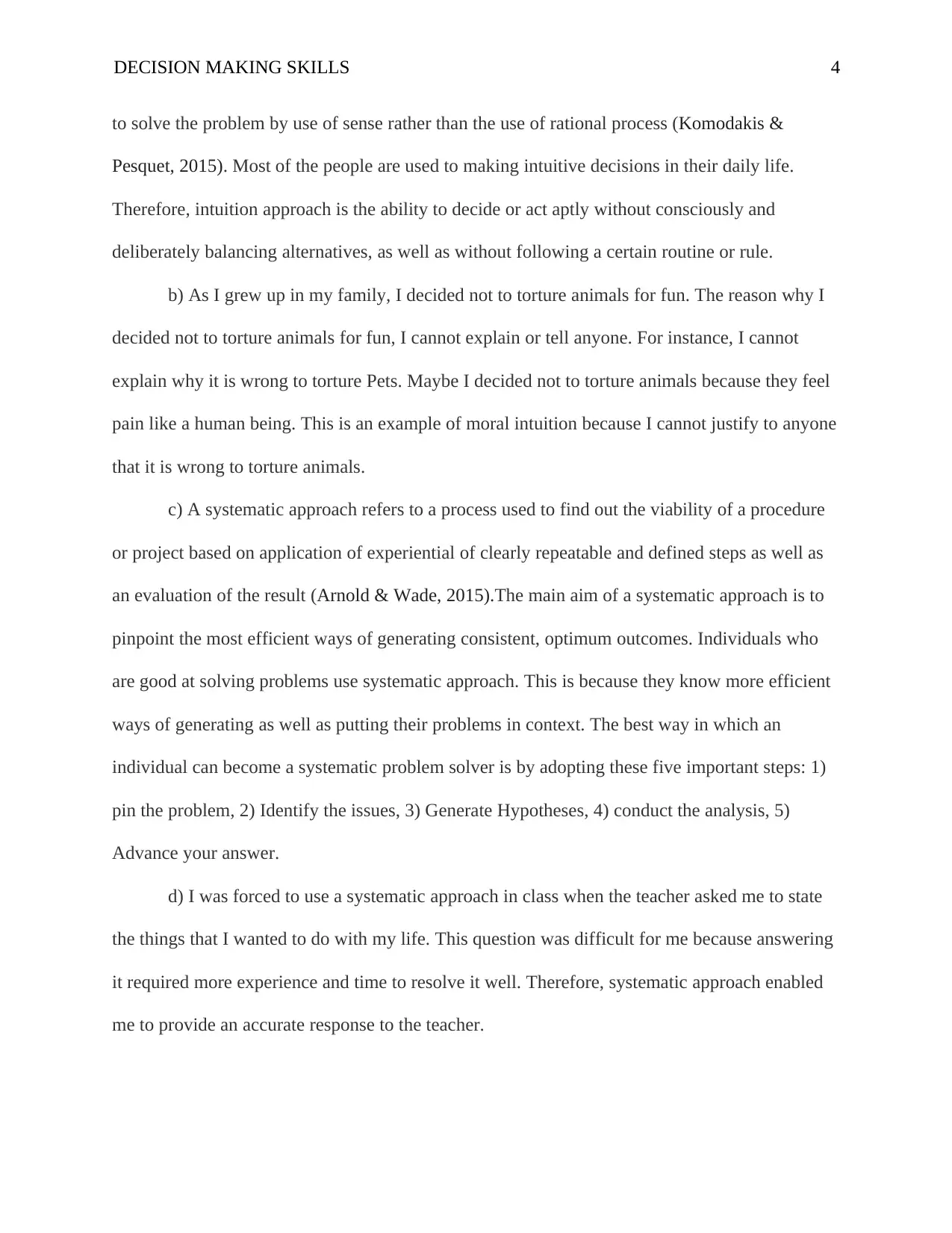
DECISION MAKING SKILLS 4
to solve the problem by use of sense rather than the use of rational process (Komodakis &
Pesquet, 2015). Most of the people are used to making intuitive decisions in their daily life.
Therefore, intuition approach is the ability to decide or act aptly without consciously and
deliberately balancing alternatives, as well as without following a certain routine or rule.
b) As I grew up in my family, I decided not to torture animals for fun. The reason why I
decided not to torture animals for fun, I cannot explain or tell anyone. For instance, I cannot
explain why it is wrong to torture Pets. Maybe I decided not to torture animals because they feel
pain like a human being. This is an example of moral intuition because I cannot justify to anyone
that it is wrong to torture animals.
c) A systematic approach refers to a process used to find out the viability of a procedure
or project based on application of experiential of clearly repeatable and defined steps as well as
an evaluation of the result (Arnold & Wade, 2015).The main aim of a systematic approach is to
pinpoint the most efficient ways of generating consistent, optimum outcomes. Individuals who
are good at solving problems use systematic approach. This is because they know more efficient
ways of generating as well as putting their problems in context. The best way in which an
individual can become a systematic problem solver is by adopting these five important steps: 1)
pin the problem, 2) Identify the issues, 3) Generate Hypotheses, 4) conduct the analysis, 5)
Advance your answer.
d) I was forced to use a systematic approach in class when the teacher asked me to state
the things that I wanted to do with my life. This question was difficult for me because answering
it required more experience and time to resolve it well. Therefore, systematic approach enabled
me to provide an accurate response to the teacher.
to solve the problem by use of sense rather than the use of rational process (Komodakis &
Pesquet, 2015). Most of the people are used to making intuitive decisions in their daily life.
Therefore, intuition approach is the ability to decide or act aptly without consciously and
deliberately balancing alternatives, as well as without following a certain routine or rule.
b) As I grew up in my family, I decided not to torture animals for fun. The reason why I
decided not to torture animals for fun, I cannot explain or tell anyone. For instance, I cannot
explain why it is wrong to torture Pets. Maybe I decided not to torture animals because they feel
pain like a human being. This is an example of moral intuition because I cannot justify to anyone
that it is wrong to torture animals.
c) A systematic approach refers to a process used to find out the viability of a procedure
or project based on application of experiential of clearly repeatable and defined steps as well as
an evaluation of the result (Arnold & Wade, 2015).The main aim of a systematic approach is to
pinpoint the most efficient ways of generating consistent, optimum outcomes. Individuals who
are good at solving problems use systematic approach. This is because they know more efficient
ways of generating as well as putting their problems in context. The best way in which an
individual can become a systematic problem solver is by adopting these five important steps: 1)
pin the problem, 2) Identify the issues, 3) Generate Hypotheses, 4) conduct the analysis, 5)
Advance your answer.
d) I was forced to use a systematic approach in class when the teacher asked me to state
the things that I wanted to do with my life. This question was difficult for me because answering
it required more experience and time to resolve it well. Therefore, systematic approach enabled
me to provide an accurate response to the teacher.
Paraphrase This Document
Need a fresh take? Get an instant paraphrase of this document with our AI Paraphraser
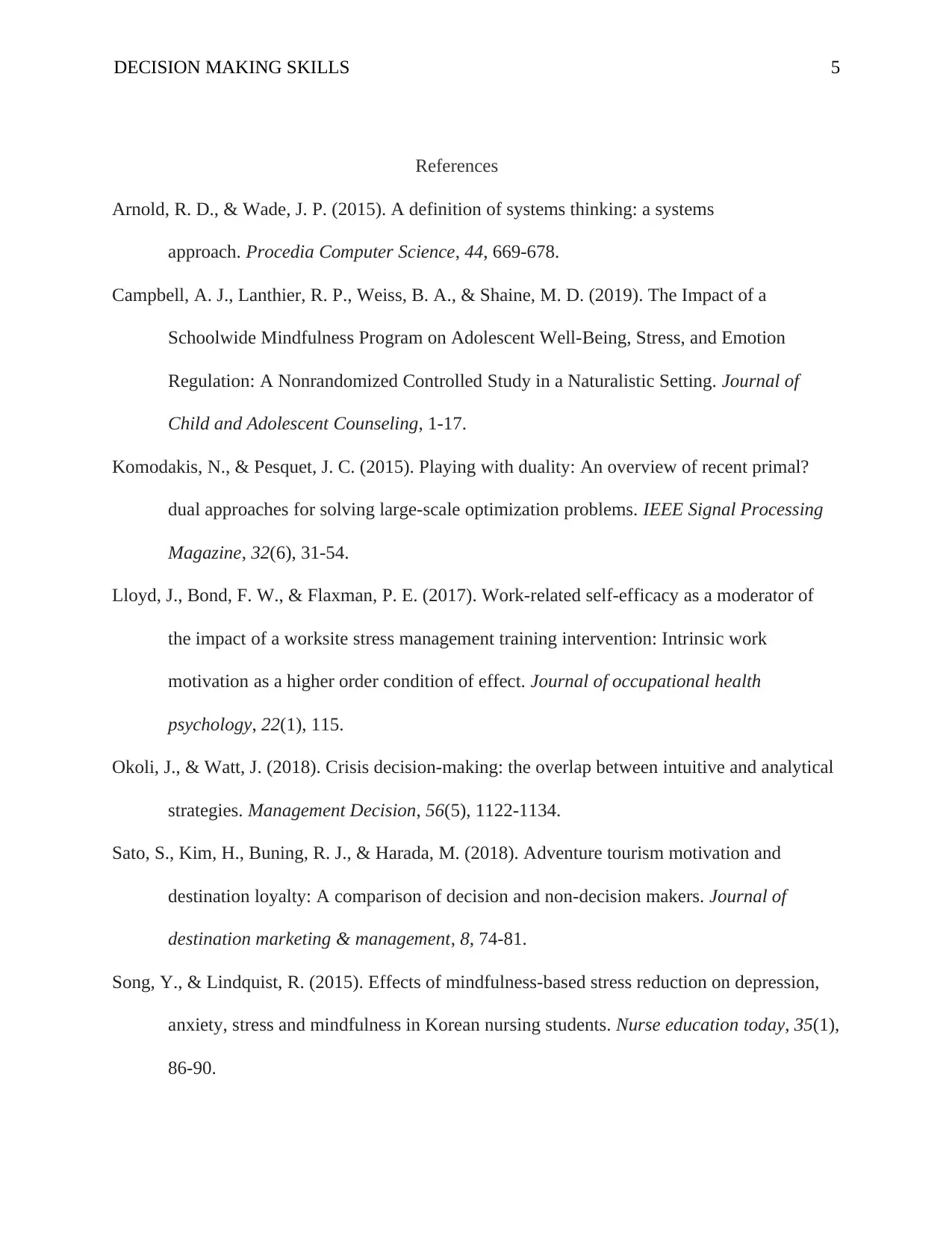
DECISION MAKING SKILLS 5
References
Arnold, R. D., & Wade, J. P. (2015). A definition of systems thinking: a systems
approach. Procedia Computer Science, 44, 669-678.
Campbell, A. J., Lanthier, R. P., Weiss, B. A., & Shaine, M. D. (2019). The Impact of a
Schoolwide Mindfulness Program on Adolescent Well-Being, Stress, and Emotion
Regulation: A Nonrandomized Controlled Study in a Naturalistic Setting. Journal of
Child and Adolescent Counseling, 1-17.
Komodakis, N., & Pesquet, J. C. (2015). Playing with duality: An overview of recent primal?
dual approaches for solving large-scale optimization problems. IEEE Signal Processing
Magazine, 32(6), 31-54.
Lloyd, J., Bond, F. W., & Flaxman, P. E. (2017). Work-related self-efficacy as a moderator of
the impact of a worksite stress management training intervention: Intrinsic work
motivation as a higher order condition of effect. Journal of occupational health
psychology, 22(1), 115.
Okoli, J., & Watt, J. (2018). Crisis decision-making: the overlap between intuitive and analytical
strategies. Management Decision, 56(5), 1122-1134.
Sato, S., Kim, H., Buning, R. J., & Harada, M. (2018). Adventure tourism motivation and
destination loyalty: A comparison of decision and non-decision makers. Journal of
destination marketing & management, 8, 74-81.
Song, Y., & Lindquist, R. (2015). Effects of mindfulness-based stress reduction on depression,
anxiety, stress and mindfulness in Korean nursing students. Nurse education today, 35(1),
86-90.
References
Arnold, R. D., & Wade, J. P. (2015). A definition of systems thinking: a systems
approach. Procedia Computer Science, 44, 669-678.
Campbell, A. J., Lanthier, R. P., Weiss, B. A., & Shaine, M. D. (2019). The Impact of a
Schoolwide Mindfulness Program on Adolescent Well-Being, Stress, and Emotion
Regulation: A Nonrandomized Controlled Study in a Naturalistic Setting. Journal of
Child and Adolescent Counseling, 1-17.
Komodakis, N., & Pesquet, J. C. (2015). Playing with duality: An overview of recent primal?
dual approaches for solving large-scale optimization problems. IEEE Signal Processing
Magazine, 32(6), 31-54.
Lloyd, J., Bond, F. W., & Flaxman, P. E. (2017). Work-related self-efficacy as a moderator of
the impact of a worksite stress management training intervention: Intrinsic work
motivation as a higher order condition of effect. Journal of occupational health
psychology, 22(1), 115.
Okoli, J., & Watt, J. (2018). Crisis decision-making: the overlap between intuitive and analytical
strategies. Management Decision, 56(5), 1122-1134.
Sato, S., Kim, H., Buning, R. J., & Harada, M. (2018). Adventure tourism motivation and
destination loyalty: A comparison of decision and non-decision makers. Journal of
destination marketing & management, 8, 74-81.
Song, Y., & Lindquist, R. (2015). Effects of mindfulness-based stress reduction on depression,
anxiety, stress and mindfulness in Korean nursing students. Nurse education today, 35(1),
86-90.

DECISION MAKING SKILLS 6
Young, H. (2017). Busy yet passive:(non-) decision-making in school governing bodies. British
Journal of Sociology of Education, 38(6), 812-826.
Young, H. (2017). Busy yet passive:(non-) decision-making in school governing bodies. British
Journal of Sociology of Education, 38(6), 812-826.
⊘ This is a preview!⊘
Do you want full access?
Subscribe today to unlock all pages.

Trusted by 1+ million students worldwide
1 out of 6
Related Documents
Your All-in-One AI-Powered Toolkit for Academic Success.
+13062052269
info@desklib.com
Available 24*7 on WhatsApp / Email
![[object Object]](/_next/static/media/star-bottom.7253800d.svg)
Unlock your academic potential
Copyright © 2020–2025 A2Z Services. All Rights Reserved. Developed and managed by ZUCOL.




